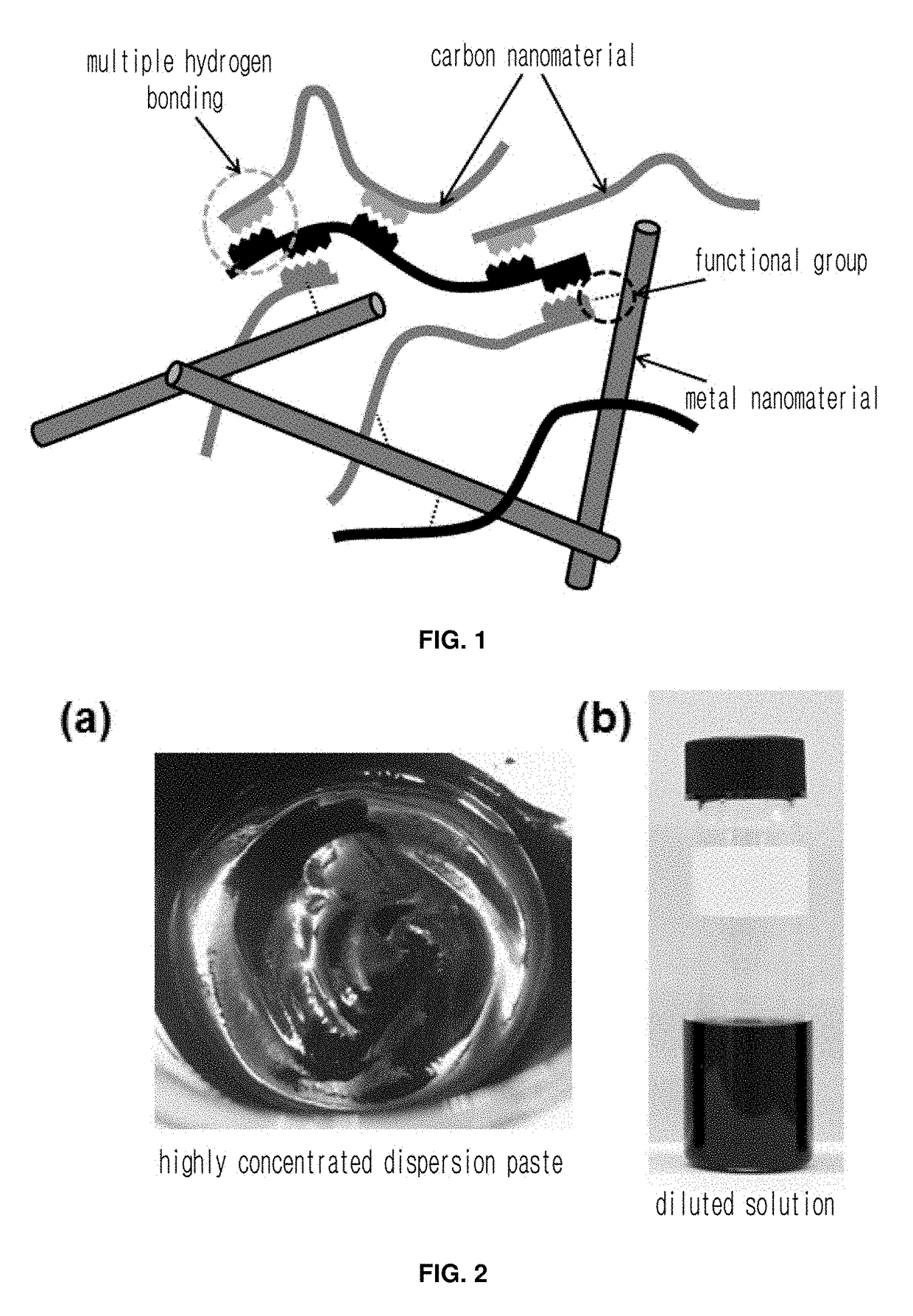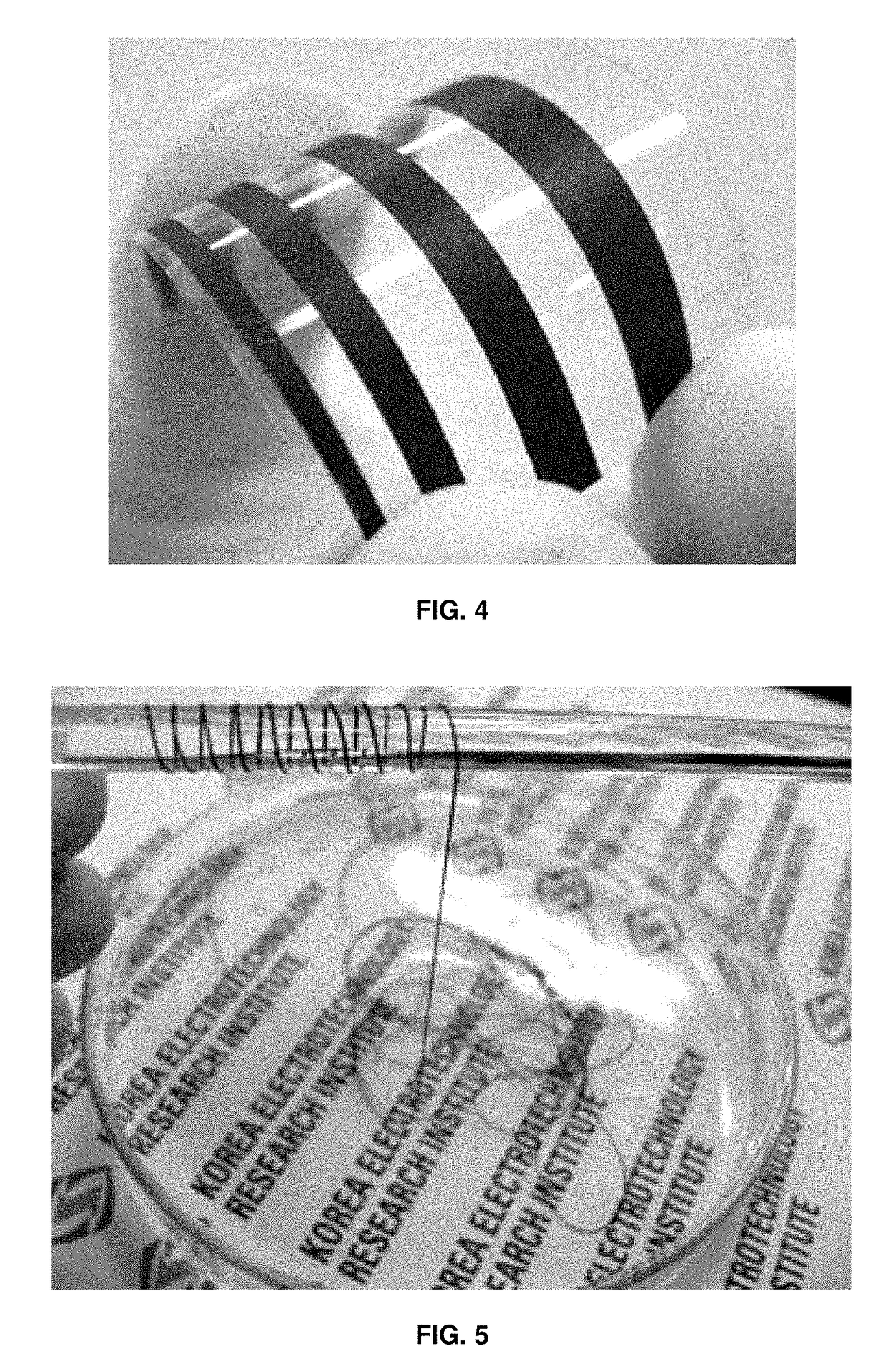Highly conductive material formed by hybridization of metal nanomaterial and carbon nanomaterial having higher-order structure due to multiple hydrogen bonding, and manufacturing method therefor
a technology of carbon nanomaterials and high-order structure, which is applied in the direction of non-metal conductors, shielding materials, conductors, etc., can solve the problems of loss of conductivity, easy dispersion of conductive materials, and inability to prepare a coating solution based on the hybridization of carbon nanomaterials with metal nanomaterials without using dispersants
- Summary
- Abstract
- Description
- Claims
- Application Information
AI Technical Summary
Benefits of technology
Problems solved by technology
Method used
Image
Examples
example 1
[0034]In Example 1, a multiwall carbon nanotube was grafted with a functional group capable of forming quadruple hydrogen bonds and hybridized with a silver nanowire.
[0035]First, 10 g of a multiwall carbon nanotube in 200 ml of sulfuric acid / nitric acid mixture (7:3 v / v) was heated at 80° C. for 24 hrs with stirring, and then cooled to room temperature.
[0036]Then, the mixture was diluted with 800 ml of distilled water. The dilution was filtered four or more times through filter paper to obtain a carboxyl group (—COOH)-grafted multiwall carbon nanotube while the acid was removed.
[0037]The carboxyl group (—COOH)-grafted carbon nanotube was dispersed at a concentration of 100 mg / L in a dimethylformamide solvent, and then grafted with isocyanate by mixing with a diisocyanate having a thiol (—SH) or amine group at 100° C. for 12 hrs while stirring.
[0038]Subsequently, the diisocyanate-grafted carbon nanotube was mixed at 100° C. for 20 hrs with amino-4-hydroxy-6-methyl-pyrimidine while st...
example 2
[0046]In Example 2, a conductive fiber was prepared a mixture of a carbon nanomaterial having a higher-order structure based on multiple hydrogen bonding, a metal nanowire, and a polymer.
[0047]Both a multiwall carbon nanotube and a chemically exfoliated graphene were grafted with a functional group capable of forming quadruple hydrogen bonds in the same manner as in Example 1, followed by mixing a silver nanowire in an amount of 3 wt % of the carbon nanomaterial to give a conductive paste with a solid content of 5 wt %.
[0048]The chemically exfoliated graphene was prepared by treating pure graphite with sulfuric acid KMnO4 for 3 days, purifying with hydrogen peroxide and hydrochloric acid to give graphite oxide, and exfoliating the graphite oxide by use of an ultrasonic processor.
[0049]To the conductive paste, a solution of polyacrylonitrile in dimethylformamide was added in an amount of 50 wt % of the solid content of the conductive paste to give a dope for use in fiber spinning.
[00...
example 3
[0052]In Example 3, a transparent electrode was prepared from a highly conductive composite material. For this, first, a functional group capable of forming multiple hydrogen bonds was introduced into single-wall carbon nanotube in the same manner as in Example 1, and the carbon nanotube was mixed with a silver nanowire in a dimethylformamide to give a paste that was then diluted to a concentration of 0.01 wt %. The dilution was applied to a plastic or glass substrate using a spray coating or slot-die coating technique to form a transparent electrode.
[0053]FIG. 6 is an image of the flexible transparent conductive film formed on a plastic substrate as prepared in Example 3. The transparent conductive film was found to have a surface resistance of 50 ohm / sq, which was decreased to 10% or less of that of the single-wall carbon nanotube alone, and to exhibit a transmittance of 85%.
PUM
| Property | Measurement | Unit |
|---|---|---|
| concentration | aaaaa | aaaaa |
| temperature | aaaaa | aaaaa |
| concentration | aaaaa | aaaaa |
Abstract
Description
Claims
Application Information
 Login to View More
Login to View More - R&D
- Intellectual Property
- Life Sciences
- Materials
- Tech Scout
- Unparalleled Data Quality
- Higher Quality Content
- 60% Fewer Hallucinations
Browse by: Latest US Patents, China's latest patents, Technical Efficacy Thesaurus, Application Domain, Technology Topic, Popular Technical Reports.
© 2025 PatSnap. All rights reserved.Legal|Privacy policy|Modern Slavery Act Transparency Statement|Sitemap|About US| Contact US: help@patsnap.com



